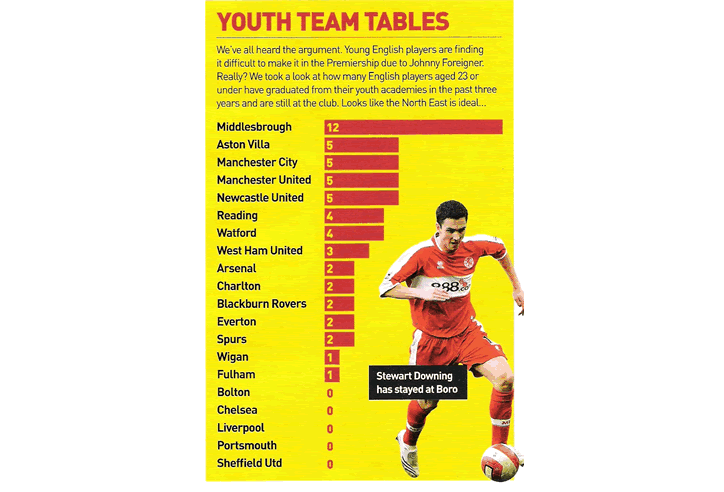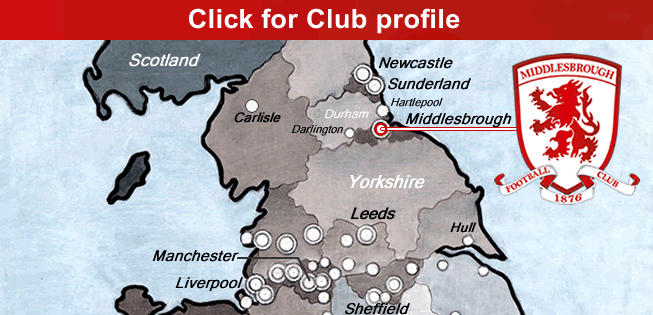…
In 1876, members of the Middlesbrough Cricket Club organized a football team, to stay fit during the winter months. This club became Middlebrough FC. The club remained amateur in it’s first two decades, and twice won the FA Amateur Cup: in 1895, 2-1, over Old Carthusians; and in 1898, 2-1 over Uxbridge. Refusal to turn professional resulted in a group breaking off to form Middlesbrough Ironopolis FC, in 1889. Ironopolis joined the Football League in 1893, but folded in 1894. MFC turned professional in 1899, and that same year were elected to join the Second Division of the League. They were promoted three seasons later, in 1902, and remained in the First Division for 18 seasons. Their best finish was in 1914, at third place. The Great War (WW I) intervened soon after. The club was relegated and then promoted, twice, between 1924 and 1929. George Camsell, from nearby County Durham, scored 59 goals to help Boro get promoted in 1927. He went on to play 14 seasons for Middlesbrough, scoring 325 league goals (5th highest, all-time). {see George Camsell bio, here} They stayed in the First Division from 1929 to 1954 (18 seasons).

World War II interrupted an up and coming Boro side that finished 4th in 1939. In 1951, the club achieved their highest attendance, averaging 36,100 (they finished 6th). Relegated in 1954, the club would remain out of the top flight for 20 seasons. Middlesbrough was relegated in 1954. The club would remain out of the top flight for 20 years. In 1958, a young Brian Clough (pronounced “Cluff”) debuted for the team. Born in Middlesbrough, he would go on to score 197 goals in 213 games for his home-town club, before moving on to Sunderland.
In 1973, World Cup hero Jack Charlton took over as manager, and guided Middlesbrough back up. The club finished in 7th place in 1975, their first season back in the First Division. But by 1982, Boro was back down to the second division. In the summer of 1986, Middlesbrough faced it’s darkest hour. Relegated to the third tier, the club had severe financial difficulties, and faced liquidation. The club was actually dissolved. However, a group led by Steve Gibson was able to gather the support necessary to register the club for the next season. The newly re-formed club became officially known as Middlesbrough Football and Athletic Club, and their new crest showed the year 1986 on it. The club gained promotion back to the second division the next season, and in 1988, Boro made it back to the top flight. They only stayed there one year, though, and for the next decade, Middlesbrough became the classic yo-yo club. They were relegated, and promoted back, three times between 1989 and 1998. In 1994, former Manchester United star Bryan Robson took over as player/manager. In 1995, Riverside Stadium was opened, with a capacity of 30,000 . The club made the surprise signing of 22-year old Brazillian footballer of the year Juninho Paulista. In 1996, they finished 12th in the Premier League. The next season (1996-97) showed promise, but ultimately turned out to be a disaster. The club had strong cup runs in both the League and FA Cups, but were deducted 3 points for failing to fulfill a fixture. They ended up losing both Cups: the FA Cup 0-2, to Chelsea, and the League Cup 0-1, to Leicester City, in the replay. And those 3 points proved to be devastating, as they finished 19th, and were relegated by 2 points. They made it back to the League Cup Final the next year, while in the second tier, but lost to Chelsea 0-2, in added extra time. Nevertheless, Boro gained promotion back to the top flight that year (1998), and haven’t been down since.
Middlesbrough has been a decent mid-table Premiership club throughout the last decade. In 2001, Steve McLaren was hired as manager. Under him, they finally won a major trophy, in 2004, claiming the League Cup with a 2-1 victory over Bolton Wanderers. They then signed Australian striker Mark Viduka, and in 2005 finished 7th, good enough to qualify for Europe, in the UEFA Cup. Their 2005-06 UEFA Cup run produced two stunning results. They came back from 3 goals down (aggregate), twice in a row. First, they did it versus FC Basel, in the quarter finals. Then they did it versus Steaua Bucharest, in the semi-finals {see these highlights from the Middlesbrough v. Steaua Buchrest 2006 UEFA Cup semi-final}. Even so, they were outclassed by repeat winners Sevilla, in the 2006 UEFA Cup Final, 0-4. In early 2006, Mclaren left to become manager of the national team of England, and captain Gareth Southgate was made manager. In 2006-07, the club finished in 12th place.
The city of Middlesbrough is, to put it mildly, charm-deficient. It has much heavy industry, but little in the way of amenities. The city was voted the worst place to live in England, in a recent Channel 4 program. Attracting top shelf players is not easy. So it is a good thing that Middlesbrough FC has made it a priority to have a solid football academy. It is, in fact one of the best in the country, and it’s system has produced more Premier League players in recent years than any other club’s {see chart, from a recent issue of FourFourTwo magazine, below}. Players like Lee Catermole, England international Stewart Downing, David Wheater, and the promising young forward Adam Johnson. Their academy should be able to provide enough talent to keep manager Gareth Southgate’s team in the top flight for the foreseeable future.

Thanks to: Historical Football Kits for the 5 older kits on the chart (historicalkits[dot]uk[dot]uk); Colours Of Football for the 3 sets of newer kits on the chart (colours-of-football[dot]com). Photos: Stadium Guide (stadiumguide[dot]com); Groundhopping Blog (btsv[dot]de); (rovers[dot]premiumtv[dot]co[dot]uk); Middlesbrough FC website (mfc[dot]premiumtv[dot]co[dot]uk); Ayresome Park tribute site (ayresome[dot]co[dot]uk); FourFourTwo magazine.

